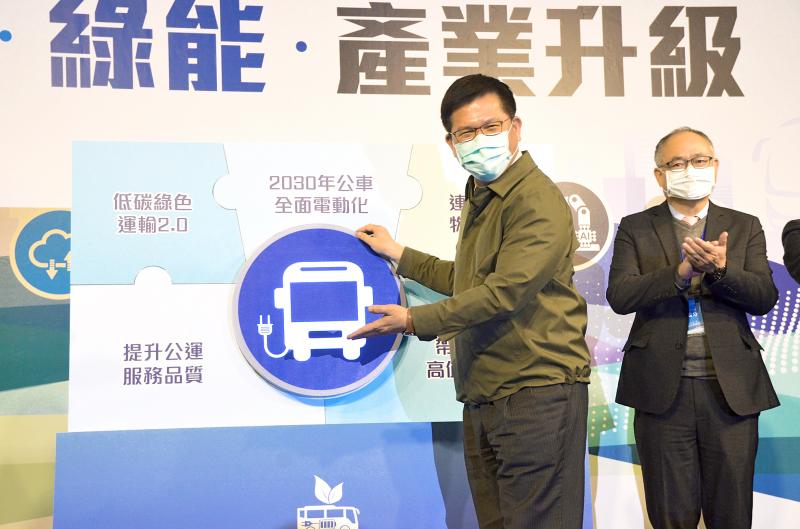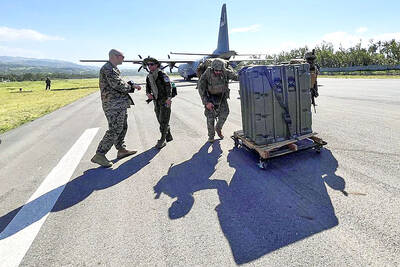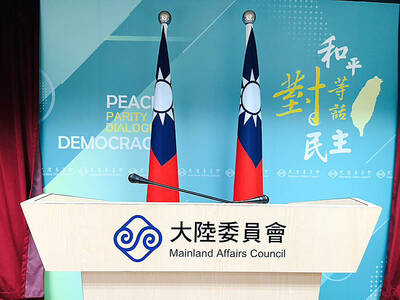The government has budgeted NT$8.5 billion (US$300 million) to develop electric buses over the next four years as part of its program to upgrade public buses by 2030, the Ministry of Transportation and Communications (MOTC) said yesterday.
Minister of Transportation and Communications Lin Chia-lung (林佳龍) announced the plan at a forum in Taoyuan on the development of electric buses, where he took a ride on buses made by Master Transportation Bus Manufacturing and RAE Electric Vehicles, the two local companies that qualified for a pilot project by the ministry.
The government aims to upgrade gasoline and diesel-powered public buses across the nation to ones powered by electricity by 2030, he said.

Photo: Cheng Shu-ting, Taipei Times
The development of electric buses would stimulate demand for public transportation systems and the growth of the nation’s electric vehicle industry, which has the potential of becoming one of the nation’s strategic industries in the next decade, he said.
Taiwan has strong components, information and communications industries, but the nation’s public transport sector is “colonized” by foreign manufacturers, he said.
“Bus operators often have to buy components from original manufacturers to maintain their vehicles, but they then find out that those firms are here in Taiwan,” Lin said. “It is a pity that we do not have a platform to integrate such information.”
“If we overcome the obstacles in the development of electric buses, Taiwan will have a opportunity to become a key nation in the industry and export electric vehicles overseas,” he said.
The pilot project is also to subsidize electric vehicle purchases by local bus operators, Lin said, adding that the firms can apply until May.
The ministry has budgeted a total of NT$20 billion over four years to increase usage of public transport, including NT$8.5 billion for electric bus development, said Michael Chao (趙晉緯), an official in the Department of Railways and Highways.
The incentives are estimated to spur developments with an output value of NT$170 billion over the next 10 years and create 56,000 jobs, Chao said.
The pilot project was stipulated in November last year to curb air pollution, enhance energy efficiency, offer quality public transportation and develop the electric vehicle industry, the ministry said, adding that it is coordinating the project with the Ministry of Economic Affairs and the Environmental Protection Administration.
To participate in the project, the two electric vehicle makers passed a two-phase review of their manufacturing expertise and business plans, the MOTC said.
Operators purchasing electric buses from Master Transportation or RAE would be subsidized up to NT$10 million per vehicle, while those buying electric buses from other firms would receive a maximum subsidy of about NT$6.3 million per vehicle.

Three batches of banana sauce imported from the Philippines were intercepted at the border after they were found to contain the banned industrial dye Orange G, the Food and Drug Administration (FDA) said yesterday. From today through Sept. 2 next year, all seasoning sauces from the Philippines are to be subject to the FDA’s strictest border inspection, meaning 100 percent testing for illegal dyes before entry is allowed, it said in a statement. Orange G is an industrial coloring agent that is not permitted for food use in Taiwan or internationally, said Cheng Wei-chih (鄭維智), head of the FDA’s Northern Center for

LOOKING NORTH: The base would enhance the military’s awareness of activities in the Bashi Channel, which China Coast Guard ships have been frequenting, an expert said The Philippine Navy on Thursday last week inaugurated a forward operating base in the country’s northern most province of Batanes, which at 185km from Taiwan would be strategically important in a military conflict in the Taiwan Strait. The Philippine Daily Inquirer quoted Northern Luzon Command Commander Lieutenant General Fernyl Buca as saying that the base in Mahatao would bolster the country’s northern defenses and response capabilities. The base is also a response to the “irregular presence this month of armed” of China Coast Guard vessels frequenting the Bashi Channel in the Luzon Strait just south of Taiwan, the paper reported, citing a

The Chinese military has built landing bridge ships designed to expand its amphibious options for a potential assault on Taiwan, but their combat effectiveness is limited due to their high vulnerability, a defense expert said in an analysis published on Monday. Shen Ming-shih (沈明室), a research fellow at the Institute for National Defense and Security Research, said that the deployment of such vessels as part of the Chinese People’s Liberation Army (PLA) Navy’s East Sea Fleet signals a strong focus on Taiwan. However, the ships are highly vulnerable to precision strikes, which means they could be destroyed before they achieve their intended

UNDER PRESSURE: The report cited numerous events that have happened this year to show increased coercion from China, such as military drills and legal threats The Chinese Communist Party (CCP) aims to reinforce its “one China” principle and the idea that Taiwan belongs to the People’s Republic of China by hosting celebratory events this year for the 80th anniversary of the end of World War II, the “retrocession” of Taiwan and the establishment of the UN, the Mainland Affairs Council (MAC) said in its latest report to the Legislative Yuan. Taking advantage of the significant anniversaries, Chinese officials are attempting to assert China’s sovereignty over Taiwan through interviews with international news media and cross-strait exchange events, the report said. Beijing intends to reinforce its “one China” principle